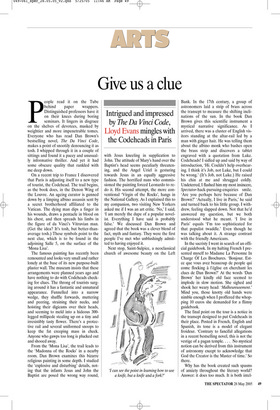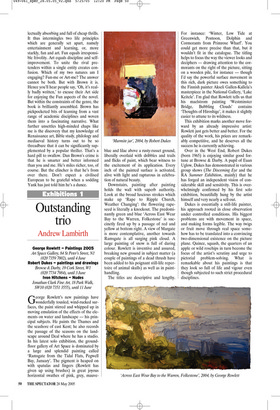Give us a clue
Intrigued and impressed by The Da Vinci Code, Lloyd Evans mingles with the Codeheads in Paris People read it on the Tube behind paper wrappers. Distinguished professors have it on their knees during boring seminars. It lingers in disgrace on the shelves of devotees, masked by weightier and more impenetrable tomes. Everyone who has read Dan Brown’s bestselling novel, The Da Vinci Code, makes a point of snootily denouncing it as tosh. I whipped through it in a couple of sittings and found it a pacey and unusually informative thriller. And yet it had some obscure quality that rankled with me deep down.
On a recent trip to France I discovered that Paris is adjusting itself to a new type of tourist, the Codehead. The trail begins, as the book does, in the Denon Wing of the Louvre. An ageing curator is gunned down by a limping albino assassin sent by a secret brotherhood affiliated to the Vatican. The dying man dips a finger in his wounds, draws a pentacle in blood on his chest, and then spreads his limbs in the figure of da Vinci’s Vitruvian man. (Get the idea? It’s tosh, but better-thanaverage tosh.) These symbols point to the next clue, which is to be found in the adjoining Salle 5, on the surface of the ‘Mona Lisa’.
The famous painting has recently been remounted and looks very small and rather lonely at the base of its new purpose-built plaster wall. The museum insists that these arrangements were planned years ago and have nothing to do with Codeheads checking for clues. The throng of tourists surging around it has a fantastic and unnatural appearance. Funnelled into a narrow wedge, they shuffle forwards, muttering and peering, straining their necks, and hoisting their digicams over their heads, and seeming to meld into a hideous 300legged millipede stealing up on a tiny and irresistibly tasty flower. There’s a protective rail and several uniformed snoops to keep the fat creeping mass in check. Anyone who gawps too long is plucked out and shooed away.
From the ‘Mona Lisa’, the trail leads to the ‘Madonna of the Rocks’ in a nearby room. Dan Brown examines this bizarre religious painting in some depth. I studied the ‘explosive and disturbing’ details, noting that the infants Jesus and John the Baptist are posed the wrong way round, with Jesus kneeling in supplication to John. The attitude of Mary’s hand over the Baptist’s head seems peculiarly threatening, and the Angel Uriel is gesturing towards Jesus in an equally aggressive fashion. The horrified nuns who commissioned the painting forced Leonardo to redo it. His second attempt, the more conventional ‘Virgin of the Rocks’, hangs in the National Gallery. As I explained this to my companion, two visiting New Yorkers asked me if I was an art critic. ‘No,’ I said, ‘I am merely the dupe of a popular novelist. Everything I have said is probably false.’ We discussed Dan Brown and agreed that the book was a clever blend of fact, myth and fantasy. They were the first people I’ve met who unblushingly admitted to having enjoyed it.
Next stop, Saint-Sulpice, a neoclassical church of awesome beauty on the Left Bank. In the 17th century, a group of astronomers laid a strip of brass across the transept to measure the shifting inclinations of the sun. In the book Dan Brown gives this scientific instrument a mystical narrative significance. As I arrived, there was a cluster of English visitors standing at the altar-rail led by a man with ginger hair. He was telling them about the albino monk who bashes open the brass strip and discovers a tablet engraved with a quotation from Luke. Codeheads! I sidled up and said by way of introduction, ‘Hi. Couldn’t help overhearing. I think it’s Job, not Luke, but I could be wrong.’ (It’s Job, not Luke.) He raised his chin at me and shrugged coldly. Undeterred, I flashed him my most insincere, Spectator-hack-pursuing-enquiries smile. ‘Are you perhaps here because of Dan Brown?’ ‘Actually, I live in Paris,’ he said and turned back to his little group. I withdrew, feeling slapped down. Not that he’d answered my question, but we both understood what he meant. ‘I live in Paris’ equals ‘I’m too sophisticated for that populist twaddle.’ Even though he was talking about it. A strange contrast with the friendly Americans.
In the sacristy I went in search of an official guidebook. In my halting French I presented myself to Madame La Personne In Charge Of Les Brochures. ‘Bonjour. Estce que vous avez beaucoup de people qui come flocking à l’église en cherchant les clues de Dan Brown?’ At the words ‘Dan Brown’ her kindly old face seemed to implode in slow motion. She sighed and shook her weary head: ‘Malheureusement.’ Mind you, those knotty old hands were nimble enough when I proffered the whopping 10 euros she demanded for a flimsy guidebook.
The final point on the tour is a notice in the transept designed to put Codeheads in their place. Posted in French, English and Spanish, its tone is a model of elegant froideur. ‘Contrary to fanciful allegations in a recent bestselling novel, this is not the vestige of a pagan temple.... No mystical notion can be derived from this instrument of astronomy except to acknowledge that God the Creator is the Master of time.’ So there.
Why has the book created such spasms of anxiety throughout the literary world? Answer: it does too much. It is both intel lectually absorbing and full of cheap thrills. It thus intermingles two life principles which are generally set apart, namely entertainment and learning, or, more starkly, fun and art. Fun equals irresponsible frivolity. Art equals discipline and selfimprovement. To unite the rival pretenders within a single entity creates confusion. Which of my two natures am I engaging? Fun-me or Art-me? The answer cannot be both. But with Brown it is. Hence you’ll hear people say, ‘Oh, it’s really badly written,’ to excuse their Art side for enjoying the Fun aspects of the novel. But within the constraints of the genre, the book is brilliantly assembled. Brown has pickpocketed bits of learning from a vast range of academic disciplines and woven them into a fascinating narrative. What further unsettles high-minded chaps like me is the discovery that my knowledge of Renaissance art, Bible study, philology and mediaeval history turns out to be so threadbare that it can be significantly supplemented by a popular thriller. That’s a hard pill to swallow. Dan Brown’s crime is that he is smarter and better informed than you and me. He’s miles richer, too, of course. But the clincher is that he’s from over there. Don’t expect a civilised European to be grateful when a sodding Yank has just told him he’s a dunce.























































 Previous page
Previous page